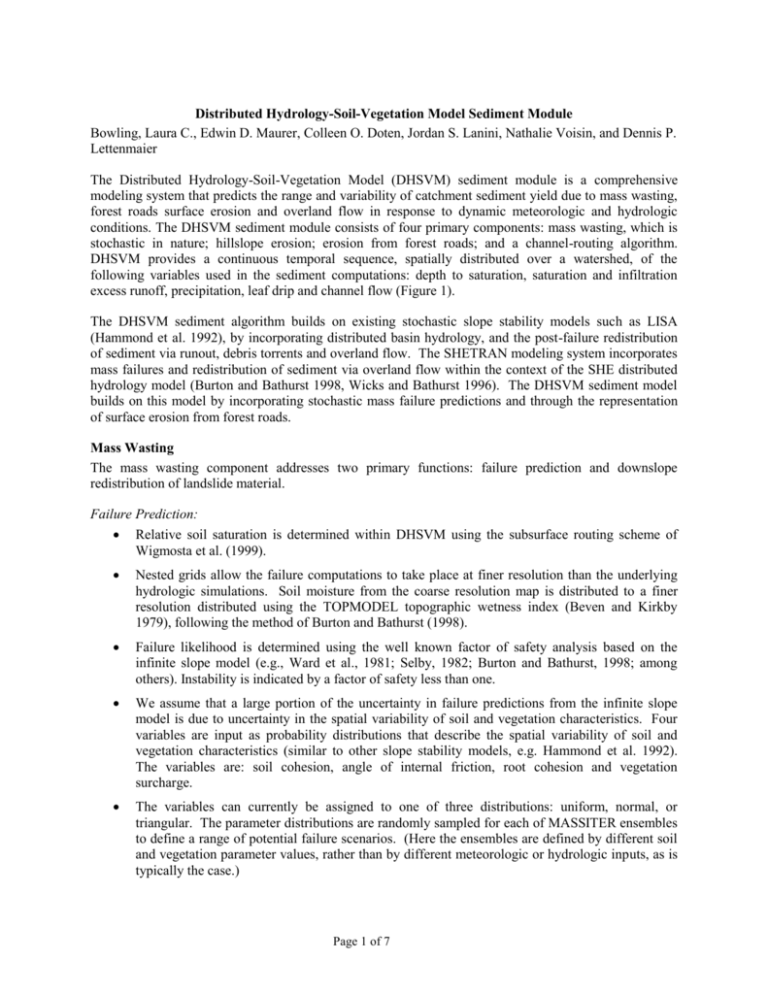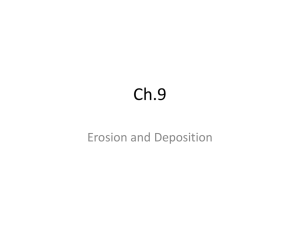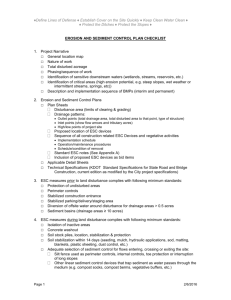Distributed Hydrology-Soil-Vegetation Model Sediment Module
advertisement

Distributed Hydrology-Soil-Vegetation Model Sediment Module Bowling, Laura C., Edwin D. Maurer, Colleen O. Doten, Jordan S. Lanini, Nathalie Voisin, and Dennis P. Lettenmaier The Distributed Hydrology-Soil-Vegetation Model (DHSVM) sediment module is a comprehensive modeling system that predicts the range and variability of catchment sediment yield due to mass wasting, forest roads surface erosion and overland flow in response to dynamic meteorologic and hydrologic conditions. The DHSVM sediment module consists of four primary components: mass wasting, which is stochastic in nature; hillslope erosion; erosion from forest roads; and a channel-routing algorithm. DHSVM provides a continuous temporal sequence, spatially distributed over a watershed, of the following variables used in the sediment computations: depth to saturation, saturation and infiltration excess runoff, precipitation, leaf drip and channel flow (Figure 1). The DHSVM sediment algorithm builds on existing stochastic slope stability models such as LISA (Hammond et al. 1992), by incorporating distributed basin hydrology, and the post-failure redistribution of sediment via runout, debris torrents and overland flow. The SHETRAN modeling system incorporates mass failures and redistribution of sediment via overland flow within the context of the SHE distributed hydrology model (Burton and Bathurst 1998, Wicks and Bathurst 1996). The DHSVM sediment model builds on this model by incorporating stochastic mass failure predictions and through the representation of surface erosion from forest roads. Mass Wasting The mass wasting component addresses two primary functions: failure prediction and downslope redistribution of landslide material. Failure Prediction: Relative soil saturation is determined within DHSVM using the subsurface routing scheme of Wigmosta et al. (1999). Nested grids allow the failure computations to take place at finer resolution than the underlying hydrologic simulations. Soil moisture from the coarse resolution map is distributed to a finer resolution distributed using the TOPMODEL topographic wetness index (Beven and Kirkby 1979), following the method of Burton and Bathurst (1998). Failure likelihood is determined using the well known factor of safety analysis based on the infinite slope model (e.g., Ward et al., 1981; Selby, 1982; Burton and Bathurst, 1998; among others). Instability is indicated by a factor of safety less than one. We assume that a large portion of the uncertainty in failure predictions from the infinite slope model is due to uncertainty in the spatial variability of soil and vegetation characteristics. Four variables are input as probability distributions that describe the spatial variability of soil and vegetation characteristics (similar to other slope stability models, e.g. Hammond et al. 1992). The variables are: soil cohesion, angle of internal friction, root cohesion and vegetation surcharge. The variables can currently be assigned to one of three distributions: uniform, normal, or triangular. The parameter distributions are randomly sampled for each of MASSITER ensembles to define a range of potential failure scenarios. (Here the ensembles are defined by different soil and vegetation parameter values, rather than by different meteorologic or hydrologic inputs, as is typically the case.) Page 1 of 7 DHSVM Sediment Module University of Washington Mass Redistribution: The redistribution of failed slope material involves estimation of the volume of failure, as well as the direction and distance of downslope redistribution. The following rules and assumptions govern this redistribution: All the sediment on the failed grid cell is routed downslope, in the direction of steepest descent based on the bedrock slope. The failure calculations then proceed in this downslope direction. The failed area is dynamically calculated by updating the local slope and soil loading maps in response to an initial failure, so that failures can continue to propagate downslope in response to the initial failure and loading. Failures occur one pixel at a time, so the minimum failure size is equal to the mass wasting resolution (set in the sediment configuration file). After pixel failures have stopped, failed material continues to run out down slope (as determined by steepest descent), until the slope angle falls below 4o or a channel is encountered. The failed sediment volume is evenly distributed among all down-slope pixels included within the runout distance (Burton and Bathurst 1998). The downslope redistribution of land slides may be dependent on the presence of overstory or planar versus convergent hillslopes, but these conditions are not currently taken into account, see Burton and Bathurst (1998). If the debris flow encounters a channel, the remaining sediment enters the channel system. If the junction angle for any tributary is less than 70o movement continues as a debris torrent (Benda and Dunne 1997). All sediment is removed from the active sediment layer of the channel segment with the passing of the debris torrent, until the next junction is encountered. For junction angles greater than 70o, all transported sediment is divided equally between the upstream and downstream channel segments. Debris flows also stop if the channel segment slope falls below 3.5o (Benda and Dunne 1997). In this case, all transported sediment is deposited in the first segment with slope less than 3.5 o. This process is repeated for multiple ensemble members, and every time a FS is calculated, new parameters are selected from the specified distributions. The changes in sediment depth due to mass wasting and deposition are tracked for each ensemble member. After computations have been performed for all ensemble members for the current time step, the changes in sediment depth are averaged to create a sediment map which is used as the initial condition for future time steps. The amount of sediment added to each channel segment, from debris flow routing, is also averaged over the ensemble members. Surface Erosion Components The surface erosion components describes the mechanisms by which sediment is eroded from hillslopes and forest roads and transported to the channel system. The hillslope erosion component is not stochastic in nature, so it does not respond to each of the MASSITER failure scenarios predicted by the mass wasting component. In addition, hillslope erosion is computed at the resolution of the hydrology model, not the mass wasting model. Currently, there is no updating of soil surface conditions as used by the hillslope erosion algorithms in response to mass wasting events. Output of the hillslope erosion component consists of lateral influxes of sediment to each stream and road channel segment. Page 2 of 7 DHSVM Sediment Module University of Washington Hillslope Processes: Overland flow is modeled using an explicit finite difference solution of the kinematic wave approximation to the Saint-Venant equations (see Chow et al. 1988). The solution time step is dynamically calculated according to the Courant condition to maintain solution stability while minimizing run time. Runoff generation for each model pixel, including infiltration excess runoff, subsurface return flow and culvert return flow is determined from DHSVM. Infiltration excess runoff as determined by DHSVM is based on either a static or dynamic maximum infiltration capacity threshold in each time step. The Smith and Parlange (1978) method of calculating a dynamic maximum infiltration capacity threshold as a function of water infiltrated has been added, in the manner of KINEROS (Smith et al, 1995). Re-infiltration of overland flow is possible, and is based on maximum infiltration capacity. Soil particle detachment by raindrop and leaf drip impact is calculated based on the estimated precipitation momentum, calculated as a function of rainfall momentum in the manner of Wicks and Bathurst (1996). Soil particle detachment via overland flow is predicted using an empirical detachment efficiency similar to Morgan et al. (1998). Sediment available for transport is routed using a four-point finite difference solution of the twodimensional conservation of mass equation such that total erosion is limited by transport capacity (Wicks and Bathurst, 1996), where transport capacity is calculated in the manner of KINEROS. If a grid cell contains a channel (either roadside ditch or stream), all sediment and water enters the channel segment at that point. Forest Road Processes: By model construct, road surface flow does not travel from cell-to-cell, but enters the roadside ditch network in the grid cell in which it was generated. The overland flow velocity for the infiltration excess precipitation generated from road surfaces (modeled in the same manner as that on the hillslopes) is determined within each grid cell using a finite difference solution of the kinematic wave approximation to the Saint-Venant equations. Routing direction is based on the road crown type. Sediment available for transport consists of particles detached by two mechanisms: raindrop and overland flow detachment. This is modeled in a manner similar to KINEROS (Woolhiser et al., 1990; Ziegler et al., 2001.) Sediment entering the road side ditch consists of that from the road surface and hillslope erosion and is routed through the road-side ditches as described in the Channel Routing Component . All road-side ditch segments have a culvert and all sediment that is routed to the culvert is discharged through the culvert. If the culvert is in a grid cell with the stream channel, the percent of the sediment discharged to the stream channel is a function of the particle size. Otherwise, all sediment is discharged to the hillslope. Channel Routing Components Sediment enters the channel system as the result of debris flows originating from the mass wasting algorithm or as lateral inflow from hillslope or forest road overland flow. All debris flows entering the channel have a constant lognormally distributed grain size distribution (Sturm 2001). The d50 and d90 size particles of the distribution are user-specified. The user specifies the number of sediment sizes and each Page 3 of 7 DHSVM Sediment Module University of Washington sediment size is tracked independently. Sediment is distributed into the number of sediment sizes according to the lognormal distribution, with the representative diameter for each size bin set at the median particle size. The debris inflow is computed on a volumetric basis, which is converted to a mass using the Komura (1961) relationship for density of a sediment mixture. Channel discharge (both streams and roadside ditches) is currently computed by DHSVM for each channel segment using a linear reservoir scheme. Sediment inflow to each channel segment at each time step consists of the sediment entering from the upstream reach(es), and the sediment added to the stream reach locally. Local contributions of sediment to a stream reach are assumed to be uniformly distributed along the reach. The sediment channel routing using the 4-point finite difference formulation from Wicks and Bathurst (1996). The mass balance is simplified by assuming the change in suspended sediment mass through the reach is small compared to the other terms, resulting in the well-known Exner equation (Exner, 1925). Solving the Exner equation for downstream sediment outflow rate. Transport is limited by the total sediment transport capacity calculated using Bagnold’s equation (Bagnold, 1966; Graf, 1971). The allowable time step for solving the equation across a reach is determined to satisfy the Courant condition, where Vst/x is set to approximately one. Page 4 of 7 DHSVM Sediment Module University of Washington MASS WASTING Soil Moisture Content Q Sediment Qsed Channel Flow Sediment DHSVM Precipitation Leaf Drip Infiltration and Saturation Excess Runoff CHANNEL ROUTING Erosion Deposition HILLSLOPE EROSION ROAD EROSION Figure 1. Sediment module schematic Page 5 of 7 DHSVM Sediment Module University of Washington References Bagnold, R.A., 1966, An approach of sediment transport model from general physics. US Geol. Survey Prof. Paper 422-J. Benda, L. and T. Dunne, 1997, Stochastic forcing of sediment supply to channel networks from landsliding and debris flow, WRR, 33 (12), 2849-2863. Beven, K.J. and M.J. Kirkby, 1979, A physically based, variable contributing area model of basin hydrology, Hydrol Sci Bull, 24, 43-69. Burton, A. and J.C. Bathurst, 1998, Physically based modeling of shallow landslide sediment yield at a catchment scale, Environmental Geology, 35 (2-3). Chow, V., David R. Maidment, and Larry W. Mays, 1988, Applied Hydrology. Exner, F. M., 1925, Über die wechselwirkung zwischen wasser und geschiebe in flüssen, Sitzungber. Acad. Wissenscaften Wien Math. Naturwiss. Abt. 2a, 134, 165–180. Graf, W., 1971, Hydraulics of Sediment Transport, McGraw-Hill, NY, NY, pp. 208-211. Hammond, C., D. Hall, S. Miller and P. Swetik, 1992, Level I Stability Analysis (LISA) Documentation for version 2.0, USDA Intermountain Research Station, General Technical Report INT-285. Komura, W., 1961, Bulk properties of river sediments and its application to sediment hydraulics, Proc. Jap. Nat. Cong. For Appl. Mech. Morgan, R.P.C., J.N. Qinton, R.E. Smith, G. Govers, J.W.A. Poesen, K. Auerswald, G. Chisci, D. Torri and M.E. Styczen, 1998, The European soil erosion model (EUROSEM): a dynamic approach for predicting sediment transport from fields and small catchments, Earth Surface Processes and Landforms, 23, 527-544. Selby, M.J., 1982, Hillslope materials and processes, Oxford [Oxfordshire]; New York: Oxford University Press. Smith R.E. and J.Y. Parlange 1978: A parameter-efficient hydrologic infiltration model, WRR, 14(3), 533-538. Smith R.E., D.C. Goodrich, D.A. Woolhiser, and C.L. Unkrich 1995: KINEROS – a kinematic runoff and erosion model. Chapter 20 in: Computer Models of Watershed Hydrology, Water Resources Publication, Highland Ranch, Colorado. pp. 697-732. Sturm, T., 2001, Open Channel Hydraulics, McGraw-Hill, NY, NY, pp. 378-380. Wicks, J.M. and J.C. Bathurst, 1996, SHESED: a physically based, distributed erosion and sediment yield component for the SHE hydrological modeling system, Journal of Hydrology, 175, 213-238. Wigmosta, M.S., and D.P. Lettenmaier, 1999, A Comparison of Simplified Methods for Routing Topographically-Driven Subsurface Flow, WRR, 35, 255-264. Woolhiser, D.A., R.E. Smith and D.C. Goodrich, 1990, KINEROS, A kinematic runoff and erosion model: documentation and user manual, USDA-Agricultural Research Service, ARS-77, 130 pp. Ziegler, A.D., T.W. Giambelluca, and R.A. Sutherland, 2001: Erosion prediction on unpaved mountain roads in northern Thailand: validation of dynamic erodibility modeling using KINEROS2, Hydrol. Process., 15, 337-358. Ward, T.J., R. Li, and D.B. Simons, 1981: Use of a mathematical model for estimating potential landslide sites in steep forested drainage basins, In: Erosion and sediment transport in Pacific Rim steeplands, Page 6 of 7 DHSVM Sediment Module University of Washington T.R.H. Davies ad A.J. Pearce (eds), IAHS Publ. No. 132, Institute of Hydrology, Wallingford, Oxfordshire, UK Page 7 of 7







